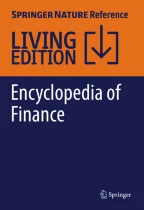Gramm-Leach-Bliley Act: Creating a New Bank for a New Millennium

The Gramm-Leach-Bliley Act of 1999 repealed the Glass-Steagall Act of 1933 that had mandated the separation of commercial banking activities from securities activities. It also repealed provisions of the Bank Holding Company Act of 1956 that provided for the separation of commercial banking from insurance activities. The result was the establishment of a new legal structure that allowed for the integration of banking, securities, and insurance activities within a single organization. The key features of the Gramm-Leach-Bliley Act are explained and discussed, with special emphasis on its importance for US banks in a world of ever-increasing competition and globalization of financial services.
This is a preview of subscription content, log in via an institution to check access.
Access this chapter
Similar content being viewed by others

Gramm-Leach-Bliley Act: Creating a New Bank for a New Millennium
Chapter © 2022

Gramm-Leach-Bliley Act: Creating a New Bank for a New Millenium
Chapter © 2013

The Private Banking Market in North America
Chapter © 2019
Notes
On October 6, 2008, the Federal Reserve Board announced that it would begin paying interest on depository institutions’ both required reserve balances and excess reserve balances.
References
- Anginer, Deniz, Ata Can Bertay, Robert J. Cull, Asli Demirguc-Kunt, and Davide S. Mare. 2019. Bank regulation and supervision ten years after the global financial crisis. Policy research working Paper 9044. World Bank, Washington, DC. Google Scholar
- Banerji, Sanjay, Andrew H. Chen, and Sumon C. Mazumda. 2002. Universal banking under bilateral information asymmetry. Journal of Financial Services Research 22 (3): 169–187. ArticleGoogle Scholar
- Barth, James R., and Yanfei Sun. 2020. Industrial banks: Challenging the traditional separation of commerce and banking. The Quarterly Review of Economics and Finance 77: 220–249. ArticleGoogle Scholar
- Barth, James R., and Clas Wihlborg. 2017. Too big to fail: Measures, remedies, and consequences for efficiency and stability. Financial Markets, Institutions & Instruments 26 (4): 175–245. ArticleGoogle Scholar
- Barth, James R., R. Dan Brumbaugh Jr., and James A. Wilcox. 2000. Policy watch: The repeal of Glass-Steagall and the advent of broad banking. Journal of Economic Perspective 14 (2): 191–204. Google Scholar
- Barth, James R., Gerrard Caprio, and Ross Levine. 2004. Bank regulation and supervision: What works best? Journal of Financial Intermediation 13 (2): 205–248. ArticleGoogle Scholar
- Benston, George J. 1990. The separation of commercial and investment banking: The Glass-Steagall act revisited and reconsidered. Basingstoke: Oxford University Press. BookGoogle Scholar
- Boot, Arnoud W.A. 2016. Understanding the future of banking: Scale & scope economies, and Fintech. In The future of large internationally active banks, ed. Asli Demirgüç-Kunt, Douglas D. Evanoff, and George G. Kaufmann, vol. 55, 429–448. New Jersey: World Scientific Studies in International Economics. ChapterGoogle Scholar
- Broome, Lissa L., and Jerry W. Markham. 2000. Banking and insurance: Before and after the Gramm-Leach-Bliley Act. Journal of Corporation Law 25 (4): 723–785. Google Scholar
- Carow, Kenneth A., and Randall A. Heron. 2002. Capital market reactions to the passage of the Financial Services Modernization Act of 1999. The Quarterly Review of Economics and Finance 42 (3): 465–485. ArticleGoogle Scholar
- Cetorelli, Nicola, and James Traina. 2018. “Resolving “Too Big to Fail.” Federal Reserve Bank of New York, Staff Report No. 859. Google Scholar
- Dahl, Drew, Andrew Meyer, and Michelle Neely. Scale matters: Community banks and compliance costs. Federal Reserve Bank of St. Louis, Regional Economist, July 2016. Google Scholar
- Filson, Darren, and Saman Olfati. 2014. The impacts of gramm–leach–bliley bank diversification on value and risk. Journal of Banking and Finance 41: 209–221. ArticleGoogle Scholar
- Hughes, Joseph P., Julapa Jagtiani, Loretta J. Mester, and Choon-Geol Moon. 2019. Does scale matter in community bank performance? Evidence obtained by applying several new measures of performance. Journal of Banking and Finance 106: 471–499. ArticleGoogle Scholar
- Kaufman, George G. 2014. Too big to fail in banking: What does it mean? Journal of Financial Stability (13): 214–223. Google Scholar
- Laeven, Luc A. 2016. Banking risks around the world: The implicit safety net subsidy approach. Working Paper. Available at SSRN: https://ssrn.com/abstract=632543
- Mester, Loretta J. 2010. Scale economies in banking and financial regulatory reform. Federal Reserve Bank of Minneapolis. Google Scholar
- Whalen, Gary. 1997. Bank organizational form and the risks of expanded activities. Office of the Comptroller of the Currency, Administrator of National Banks 97 (1). Google Scholar
- Wilmarth, Arthur E., Jr. 2002. The transformation of the U.S. financial services industry, 1975–2002: Competition, consolidation and increased risks. University of Illinois Law Review (2): 215–476. Google Scholar
- World Bank Group. 2020. Bank regulation and supervision a decade after the global financial crisis, Global financial development report. Washington, DC: World Bank Group. Google Scholar
Author information
Authors and Affiliations
- Auburn University and Milken Institute, Auburn, AL, USA James R. Barth
- Troy University, Troy, AL, USA Shen Zhang
- James R. Barth

